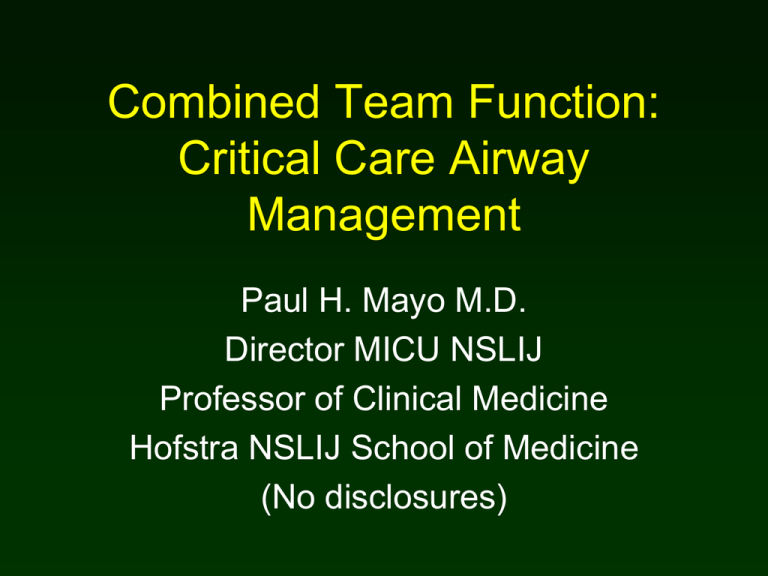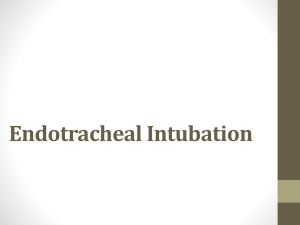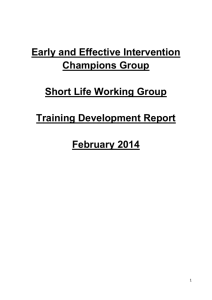Critical Airway Management – Dr Mayo
advertisement

Combined Team Function: Critical Care Airway Management Paul H. Mayo M.D. Director MICU NSLIJ Professor of Clinical Medicine Hofstra NSLIJ School of Medicine (No disclosures) A Word About OR Endotracheal Intubation • Very well studied • Very low rate of complication • Very high rate of success Why? • • • • • • • Perfect operational environment Optimal patient physiology Full airway evaluation and preparation Elective advanced airway methods Wake-up/back out option available Highly skilled intubators Awake FOB option Emergency Endotracheal Intubation (EEI) • Any endotracheal intubation that does not occur in the operating room • Venues: ICU, wards, ED • Providers at in USA include critical care staff, anesthesiologists (attending and NP), and EM staff • Often occurs in the context of training house staff What About EEI? • • • • • • Poor operational environment Highly abnormal patient physiology Difficulty in airway evaluation No time to anticipate or prepare No wake-up and back-out option Personnel may be in training How Dangerous is EEI? • Four large studies describing EEI performed by anesthesiologists • Mortality 2% • Serious complication: 25% (profound hypotension/desaturation) • Esophageal intubation: 10% • EEI: the most dangerous critical care procedure Severe hypotension 25% Jaber S, Crit Care Med 2006 Problems with EEI • EEI is required in critically ill patients who have limited physiological reserve • They are hemodynamically unstable or…. • They have respiratory failure or…, • They have both Death and Brain Injury • Related to underlying illness and the need to use sedating agents for EEI, patients are at very high risk for hypoxemia and/or hypotension • Hypoxemia and/or hypotension result in brain injury and if prolonged….death A Quiet Epidemic • Even brief periods of hypotension and/or hypoxemia may cause brain injury • Many patients recover from critical illness but have permanent brain injury • I believe that many of these cases derive from problems related to EEI that are not documented The Sad Truth • The intubation sequence frequently results in significant desaturation and hypotension • The patient survives the critical illness but has suffered brain injury • There is no back-up plan • They (and we) engage in selective memory, white washing, and “it’s the patients fault” defense Some Disturbing Facts • The 80/80 rule: anesthesia residents are successful 80% of the time on the 80th case….for routine OR intubation • The learning curve flattens out at between 500 to 1000 for OR EI • EEI is much more difficult than routine OR EI • How many EEI have you performed? Why Does EEI Go Wrong? • • • • The lone ranger syndrome Blame the patient The under the radar effect Lack of hard endpoints: Saturation, BP, attempts, failures, complications • Lack of transparency in documentation • Clinical chaos, CMA, lack of team effort, emotional issues, low frequency effect The Plight of the Anesthesiologist • • • • • Unfamiliar operating environment Unfamiliar personnel Lack of back-up personnel Lack of back-up plan Abrupt extreme clinical pressure The Plight of the Intensivist • • • • Unstable patient with high risk airway Low frequency/high risk event Abrupt extreme clinical pressure Obligation to train inexperienced personnel in the most dangerous procedure of critical medicine • Often in USA….non-expert level intubating skills Should EEI Be Entirely Under Anesthesiology Control? • Repeated examples of profound failure of EEI when Anesthesiology was in primary control • A need to train fellows • A perception that careful CQI analysis might improve EEI sequence The Challenge • How to intubate the critically ill patient safely in a training environment • Simple goals: SaO2>90%, systolic BP> 100 systolic, stable cardiac rhythm, and successful ET intubation performed by the trainee • Alternative: Call for anesthesiology as primary or immediate back-up intubator Improve the Process • Define the process in segmental detail • Identify points of improvement • Improve those that are most likely to yield greatest benefit…. “low hanging fruit” • Always measure effect, and proceed with continuous segmental process improvement The Very Low Hanging Fruit • The best way to avoid desaturation is to have a well saturated patient • We observed terrible bag mask ventilation (BVM) technique during EEI • Solution: train an army of BVM experts • Who to train: an army of medical interns • How to train: scenario based training with a computerized patient simulator (SBT with CPS) Other Low Hanging Fruit • High risk low frequency events require team work; this requires a team leader • We observed poor team function and absence of team leadership • Solution: train team leaders • Who: PCCM fellows • How: SBT with CPS Other Low Hanging Fruit • A complex process should be done in a standardized manner • We observed marked variation in set up • Solution: develop a standard approach • Who: PCCM faculty and fellows • How: read, discuss, review clinical events….constantly rethink and refine Other Low Hanging Fruit • Only qualified clinicians should perform a difficult procedure • Solution: only qualified clinicians should perform the act of intubation • Other team members perform critical tasks for which they are trained Other Low Hanging Fruit • EEI set up requires a well planned bailout plan • Solution: develop a plan and acquire the equipment High Hanging Fruit • How to find it? • Detailed debriefing following EEI • Solution: improve process by identifying failure points Examples • • • • Addition of PEEP valve to BVM Careful briefing of medication nurse Separation of pressor from sedative External auditory meatus horizontal to supraclavicular notch • Careful head positioning in the obese • RUQ ultrasound/ response to emesis • Load pressor line/early use of pressor Combined Team Function • Used by military, police, fire fighters • For high risk/low frequency events • Characterized by CRM communication, simulation training, analysis of process • Can it be adapted to the ICU? The Team • The team is composed of crew members • A crew is one or more in number and is highly skilled in their assigned task • The team leader is in overall charge and is trained in crew resource management 1. Team leader ( Fellow ) 4. Medicator/Equipment Set-up • directs the team • prepares the intubation equipment • is the primary intubator • Runs checklist • nurse(s) • gives medications with call-back • Sets up equipment/monitoring • Maintains situational awareness 2. Bag valve mask crew 5. Supervisor • Two 1st year house officers • set up bag/mask equipment • start bag/mask ventilation once patient sedated* • helps in general setup • available as backup intubator • corrects any safety violations if needed 3. Watcher 6. Standard crew positions • house officer • calls out vital signs every 30 seconds • escalates communication if team leader violates predetermined cutoffs • bagger on patient right • mask holder at head of bed • team lead on patient left • medicator at IV site • watcher at foot of bed The EEI Team • The team leader: directs the crews, and performs the intubation • The airway crew (2): BVM ventilation • The medication nurse • The watcher: responsible for monitoring V.S./saturation and calling cutoffs • The supervisor: for advanced back-up SBT with CPS for EEI • How to train the airway crew? • How to train the leader? Training The Airway Crew • All medical interns receive individualized one on one SBT training • Perfect performance in BVM ventilation required at end of training • Mayo PH et al. Achieving house staff competence in emergency airway management: results of a teaching program using a computerized patient simulator. Crit Care Med 2004 ;32:2422-7 • Results in an army of interns highly skilled in BVM ventilation The Airway Crew • Critical element in EEI • Goal is to maximally saturate the patient to a stable plateau value before any attempt • Intubation function separate from BVM ventilation • Their function is to defend saturation The Airway Crew • Absolutely critical to safe operation • Standard ACLS training completely ineffective • Intensive SBT training is key element to success The Watcher • Calls out BP and saturation every 30 seconds • Red flags cut-off violation • Avoids inattention and distraction error • No other responsibility Nurse Crew • Sets up medication, pumps, monitoring • Listens only to the leader • Calls back all orders • Medication nurse and the watcher need bedside briefing • Maintains situational awareness Training the Leader • Repeated small group training in July • Each fellow rotates through each crew responsibility multiple times • Initial repeated task training, then interrupted SBT, finally full out SBT • No OR rotation for intubation training Training the Leader • CPS used both as a simple task trainer and as full SBT device • Physical practice of setting up the environment, equipment, and personnel • Use of basic CRM • Video debriefing • Mastery of a comprehensive checklist CRM • • • • • • • • • Call back all orders Identification/briefing of crew members Use of command voice/presence No non-pertinent communication Communication through team leader Red flag all critical events Post-event debriefing Mandatory checklist Situational awareness The Checklist • • • • • • • Airway evaluation Patient set-up Equipment set-up Personnel set-up Pharmacology-up Cut off/bail-out Verification Table 3. Checklist for emergency endotracheal intubation 1. Airway Evaluation Mouth Opening (cm) Mallampati score Dentures/dentition Difficult anatomy TM distance (cm) Neck extension Prior difficult intubation Gastric contents with US 5. Cutoff/Bailout Plan Stop intubation attempt if saturation drops more than 5% below maximum achievable by bag mask ventilation; re-bag patient to maximal saturation Bailout options: supervisor attempt, intubating stylet, trans-tracheal jet ventilation, mini-cricothyroidotomy, fiber-optic bronchoscope, laryngeal mask airway 2. Patient Setup Bed away from wall Headboard off Side rails down Patient well-positioned (centered in bed, vertex at head of bed) Head fully supported in sniffing position LUQ ultrasonography Stomach suctioned (if gastric tube in place) Unnecessary equipment/furniture cleared from around bed 6. Pharmacology Sedation dose Pressor on standby loaded in IV line; immediate use to maintain systolic blood pressure > 90mmHg 3. Equipment setup Suction catheter placed to right of patient head BVM connected to O2 (10L/min) Oral airway at head of bed ETCO2 at head of bed Laryngoscopes ready and placed to left of patient head ETT checked and placed to right of patient head 7. Verification sequence End tidal carbon dioxide detector color change Tube frost Bilateral breath sounds Resaturation Back-up: direct visualization of tube through vocal cords Fiber-optic scope 4. Crew Setup Airway crew assigned and instructed Supervisor identified Watcher assigned & instructed Blood pressure by A-line or non invasive cuff (every 2 min) Continuous EKG monitoring and pulse oximetry Reliable IV access Pulse oximeter and BP cuff on contralateral arms PEEP valve (10cm H2O) on BVM Advanced airway equipment at bedside Cutoffs identified Nurse assigned and instructed Crew members in standard position 8. Debriefing Formal post-procedure debriefing with fellow and attending Quality Assessment • Continuous saturation and blood pressure measurement • Audio recording of EEI • Formal scoring of audio • “You can run but you can’t hide” Outcomes • • • • • • • Number of intubation attempts Duration of intubation attempts Verification of tube placement Compliance with checklist Hypotension Hypoxemia Complications So What Happens if…. • The MICU team assumes responsibility for all EEI and does not “cherry pick”? • By policy, anesthesiology is not called….ever? • The team leader is a fellow trained with 20 hours of intensive simulation training? • The bagging team are two interns who are heavily pre-trained and have no other function? What Happens if…. • There is mandatory 42 point check list? • CRM communication is standard? • There is a watcher, medicator and attending supervisor for true combined team tactics? • There is debriefing following each EEI? • An ongoing iterative process of quality improvement? What Happens if…. • If there is truly accurate determination of the important endpoints of EEI • So that the team can work to improve safety • And not just blame the patient or notch up another “successful” intubation while there has been neuro injury that is covered up by a long MICU stay? What Happens if…. • The EEI team recognizes that the patient is extremely vulnerable to brain injury and organ damage from…. HYPOXEMIA and HYPOTENSION • The EEI team focuses on defense of physiological function rather than the endotracheal intubation itself Complications of EEI Comment • Lowest complication rates compared to EEI reports in anesthesiology literature • Iterative process analysis combined with sequential quality improvement • Focus on defense of physiology • Combined team approach • Sustainable and transferable Query #1: Ultrasonography? • Koenig SJ, Lakticova V, Mayo PH. Utility of ultrasonography for detection of gastric fluid during urgent endotracheal intubation. Intensive Care Med. 2011 ;37:627-31 • The last two deaths that I saw were related to death by drowning from unrecognized gastric content • Also useful for post intubation trouble shooting Save a Life Query #2: 10% Esophageal Intubation!!!!???? • • • • • Similar to anesthesiology reports on EEI Inexperienced fellows at work? High rate of difficult airway Not a problem if recognized promptly Still….is there a solution? Standard Larnygoscopy • • • • • • Works well in the OR Patients are pre-screened Recognized DA?: awake FOB Patients start with favorable physiology Very high skill level with SL “Wake up and back out” option available SL in “The Jungle” • • • • • • Usually works well in the in ICU Patients are not pre-screened Recognized DA?: FOB not an option Patients have unfavorable physiology Limited skill level with SL No “Wake up and back out” option Enter the Video Laryngoscope Complications of SL vs. DL 90% 80% 70% 60% 50% 40% SL 140 30% VL 252 20% 10% 0% sb 0m 7 p< m Hg n 0% io 8 t t< ra i a p s as o es th a de t in l ea g a ph n io t a ub m SL 140 3% 6% 1% 0 VL 252 6% 12% 2% 0 t ou h y ur j in 19% <1%(0.4) ng i nd e t at 1% <1%(0.8) lt u c ffi i d pt pt m m te te t t a ta d s n 1 2 14% 22% 54% 24% 10% 7% 79% 14% VL: A Game Changer • For the intensivist: VL is mandatory as primary device • Any other approach violates mandate of patient safety • High probability that VL will be industry standard within several years Other Questions • • • • RSI versus graded sedation? Cannot bag/cannot intubate? Standard vs. disposable VL Super high risk patients Awake Fiberoptic Intubation • Widely used for recognized difficult airway in the OR • Can be adapted to ICU/EM use • Not for unstable or agitated patients • Not for non-patent upper airway • Requires careful execution to avoid dangerous pitfalls Prepare for Failure! • Set up full equipment and team as for standard EEI • Prepare for urgent bailout solution • Train on simulator with bronchoscope Upper Airway Anesthesia is Essential • Heavy application of lidocaine gel to posterior 1/3 of tongue • Consider nebulized lidocaine • Forget about local nerve blocks Specialty Airway is Mandatory • Mallampati or variant Bronchoscope • Large diameter • Must have suction channel • Operator must practice on task trainer before patient use Crew Member #1 • The oxygenator • Only assignment is to blow high flow 02 into the airway throughout procedure • This may be supplemented with mask • Additional method: put 02 through suction channel Crew Member #2 • Inserts specialized airway • Inserts ET tube into airway until tip is at end of airway (pre-measured) • Holds airway in place throughout • Holds ET tube in vertical position • Slides ET tube forward when indicated Crew Member #3 • Inserts bronchscope into ET tube • Passes vocal cords • Inserts to carinal level Crew Member #4 with #2 • Rotates ET tube clockwise 900 • This allows easier passage of ET tube • If ET tube does not advance, uses laryngoscope to straighten out airway • May also perform jaw thrust Problems • • • • ET tube bronchoscope size mismatch Solution: smaller ET tube or larger FOB Lack of visualization Solution: reposition ET tube, perform jaw thrust, practice on task trainer • Desaturation when hung up on cords • Solution: put 02 on suction port of FOB Consider This Option • For the patient with RDA and very unstable oxygenation function • Nasal bilevel NIV throughout the procedure Reminder • Practice fiberoptic intubation in simulation training environment • With your whole team….repeatedly • Practice bronchoscopy with task trainer….repeatedly








